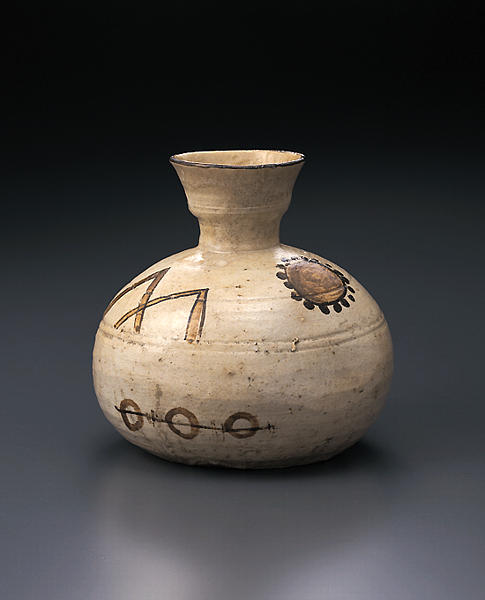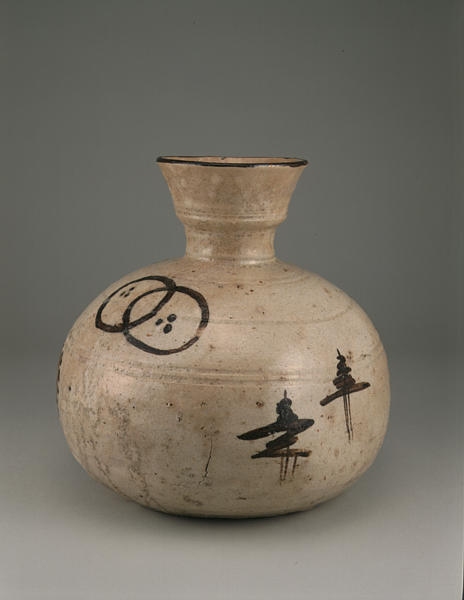志野織部徳利
- 岐阜県・美濃・弥七田窯
- 江戸時代
- 17c
- 美濃陶製
- H-20.8 D-22
江戸時代 17世紀
高:20.8cm 口径:9.7cm 胴径:21.6cm 底径:13.5cm
肩部に二,一,二の合わせて五条の凹線がめぐらされており,最下段の二条の下から底部にかけて轆轤回転を利用した削りが施されている。鉄絵の具で文様を下絵付けし,底裏を除いて長石釉を掛けただけで,銅緑釉は全く使われていない。長石釉の溶け具合から判断して,連房式登窯で焼かれたと考えられる,いわゆる志野織部である。強く胴が張って底径が大きい舟徳利形の形態であるが,箱書(蓋表墨書)には「織部 置花生」とあり,ある時期には花生として使われていたものらしい。
この大徳利は,いわゆる桃山陶のなかに類品を見つけることが難しく,これまで織部焼としては最も新しい一群である弥七田織部の範疇に属するものと考えられてきている。しかし,長石釉がやや黄色味をおびる典型的な弥七田織部の釉調ともやや異なるので,あるいは今少し下る時期に作られたものと考えるべきかもしれない。なお,底裏に「いろ」の墨書銘が認められるが,何を意味するものかはわからない。 (尾野)
志野織部(しのおりべ)
志野と同じ技法で大窯で焼かれたもので、火色は出ず、鉄絵の部分も黒みの強いものが多く見られます。次世代の連房式登窯(れんぼうしきのぼりがま)の作品にも同種のものがあって、大窯作品との区別は難しいですが、大窯のものは志野、連房式登窯のものは志野織部とされています。
Catalogue Entry
Edo period, 17th century
Oribe ware, Shino-Oribe type, underglaze and overglaze enamel
Height, 20.8cm; mouth diameter, 9.7cm;
torso diameter, 21.6cm; base diameter, 13.5cm
The shoulder is circled with 5 indented lines in a 2-1-2 pattern, and there is a carved, wheel-turned decoration between the bottom double-indented line and the base. Underglaze iron was used to create an underglaze pattern, and with the exception of the bottom of the foot, the entire jar has been coated in feldspathic glaze. There is absolutely no use of the commonly-seen Oribe copper-green glaze. Given the degree to which the feldspathic glaze dissolved, this jar appears to have been fired in a climbing kiln with connected chambers. This is an example of what is known as Shino-Oribe ware. The torso is sharply swollen, and the base is large, forming the tokkuri shape known as funatokkuri for its use on ships. The box inscription noted in black ink on the exterior of the box lid states "Oribe, okihanaike," or Oribe ware resting flower vase. Thus, it would appear that at some time in its history the jar was used as a flower vase.
It is hard to find comparative examples of this large tokkuri form in Momoyama period ceramics, and it can be considered part of the group known as Yashichida Oribe, the last Oribe ware group. However, the feldspathic glaze differs somewhat from the slightly yellowish-tinged feldspathic glaze seen on Yashichida Oribe, and thus this work might have been created a bit after that period. The base of the jar has been inscribed in black ink with the Japanese kana characters "i-ro," but the meaning of this inscription is unclear. YO
解説(春の玉手箱)
長石釉の溶け具合から判断して,連房式登窯で焼かれたと考えられる,いわゆる志野織部である。安定した姿は舟徳利とも思われる。つきたての餅が垂れたようなたっぷりとした胴の膨らみが、いかにも自然な感じがして愛らしい。胴部に鉄絵で、輪つなぎ文、山や太陽や樹木を抽象化したような文様、また底部に近い個所には串団子様の模様が描かれる。それらは何気なく奔放に書き散らしたようでいて、よく見ると実にバランス良く配されており、豊満な器体と相俟ってユーモラスな印象を与えている。また杯状に開いた口縁を鉄で黒く引き締め、頸部胴部に巡らされた凹線もアクセントとなっていて、ゆったりしながら細部に至るまで洒落た心使いがなされている。箱書(蓋表墨書)には「織部 置花生」とあり,ある時期には花生として使われていたものらしく、このように個性的な器を取り合わせて楽しんだ、代々の所蔵者たちの自由な眼の動きには感心させられる。

